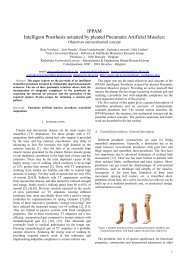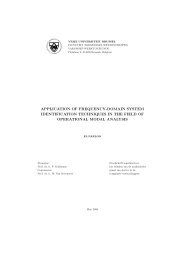VRIJE UNIVERSITEIT BRUSSEL Acoustics - the Dept. of ...
VRIJE UNIVERSITEIT BRUSSEL Acoustics - the Dept. of ...
VRIJE UNIVERSITEIT BRUSSEL Acoustics - the Dept. of ...
Create successful ePaper yourself
Turn your PDF publications into a flip-book with our unique Google optimized e-Paper software.
14 CHAPTER 1. FUNDAMENTAL CONCEPTS OF ACOUSTICSp 2 over a short time period, negligible with respect to <strong>the</strong> fly over time.In this case <strong>the</strong> time interval for integration is important.3. Physiological experiments have allowed to see that for <strong>the</strong> human ear<strong>the</strong>soundintensityimpressioncansometimenoticeablychangein0.1sec.Consequently this is a maximum value <strong>of</strong> time integration for variablesound.4. Technical application (<strong>the</strong> measuring equipment is based on this) : <strong>the</strong>integrationinterval istakenrelatively short (e.g. 125ms), such that<strong>the</strong>needle<strong>of</strong><strong>the</strong>measuring equipment iscapable<strong>of</strong>detecting relative quickfluctuations <strong>of</strong> <strong>the</strong> sound pressure; a sound whose variating intensity intime is perceived by <strong>the</strong> human ear. The measurement system deliversa result that variates in time approximately in <strong>the</strong> same way. Themeasured values for p eff are more or less located between followinglimits :2×10 −5 Pa < p eff < 200 Pa (1.25)The ratio <strong>of</strong> <strong>the</strong> largest limit to <strong>the</strong> smallest is 10 7 , which is very large.All <strong>the</strong> common sounds are situated between those limits. For this reason,andalso because earlier onebelieved thatahuman hearsaccordingto <strong>the</strong> law <strong>of</strong> Weber–Fechner, i.e. logarithmic, one have introduced <strong>the</strong>dB-scale (response proportional with <strong>the</strong> logarithm <strong>of</strong> <strong>the</strong> stimulus).1.5.2 The dB-scaleThe dB-scale allows us to describe sound, like a person perceives, in a correctway. The sound pressure level (SPL) is defined as :L p = 10log p2p 2 0= 20log p p 0(1.26)with p 0 = 20 × 10 −6 Pa <strong>the</strong> reference pressure (it equals <strong>the</strong> threshold <strong>of</strong>human hearing). An example <strong>of</strong> <strong>the</strong> dB-scale and a comparison with <strong>the</strong>linear scale is given in Figure 1.2.The hearing threshold equals 0 dB, <strong>the</strong> pain threshold is 120 dB. Calculatingwith dB causes <strong>of</strong>ten problems because <strong>of</strong> <strong>the</strong> fact that we are used towork with <strong>the</strong> linear scale. Summation and subtraction are best performedby first transforming to <strong>the</strong> linear scale, <strong>the</strong>n by executing <strong>the</strong> operation andfinally by transforming back to <strong>the</strong> dB-scale. For <strong>the</strong> sum <strong>of</strong> two values L p1en L p1 :L p = 10log(10 Lp 1 /10 +10 Lp 2 /10 ) (1.27)
















